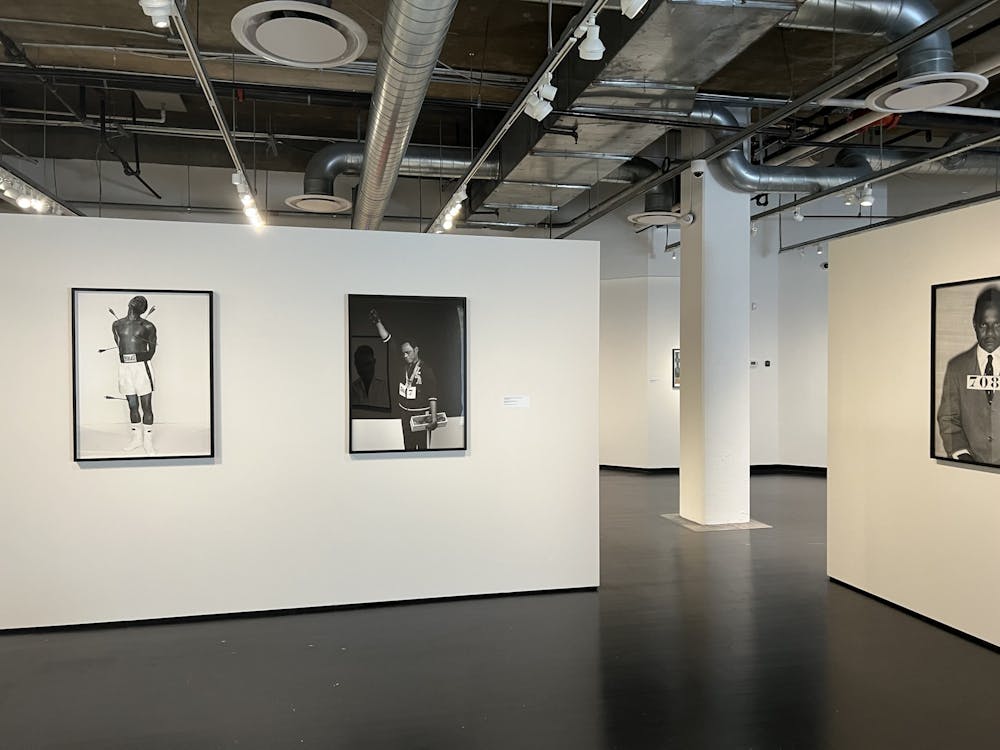The art exhibition “Samuel Fosso: Affirmative Acts” is currently on display at Art on Hulfish, a satellite gallery of the Princeton University Art Museum tucked behind the Nassau Inn. The exhibition, which runs from Nov. 19 to Jan. 29, highlights the life and work of Samuel Fosso, a Nigerian-Cameroonian photographer who specializes in self-portraiture.
The Hulfish exhibition is presented in a chronological fashion, wrapping around the walls of the room, demonstrating Fosso’s progression as an artist. His initial photographs, a series from the 1970s, were developed from unused film he had after spending days photographing sitters for portraits. The stark black-and-whiteness of the pictures highlights Fosso’s creative use of posing and fashion. He dons patterned shirts, large sunglasses, and wide-legged pants, challenging the social norms at the time.
Fosso’s staging is striking — in various pictures, he props a foot on a stool, peers out through a set of curtains, or engages the viewers directly by looking directly at them. His initial photographs, despite the austere lack of color, have a vibrancy and playfulness, contrasting the war and illness that surrounded his life at the time. Fosso’s inventive fashion and photography acted as an escape from the harsh world around him.
Fosso’s 1997 collection, a collaboration with French discount retailer Tati, exhibits his departure from the black-and-white photos of the 1970s. Despite this transition to color, certain themes remain in Fosso’s work, such as his desire to communicate social messages through his work. For example, one photograph displays Fosso seated against a brightly patterned backdrop. Red shoes rest adjacent to his bare feet while Fosso holds a collection of tall sunflowers. He wears equally patterned clothes and a pair of white sunglasses. The photograph is called “Le Chef qui a vendu l’Afrique aux colons,” or “The Chief Who Sold Africa to the Colonists.” Through the busy colors and designs of the piece, Fosso communicates a clear social message about the role of African leaders in colonization and their complex relationship with imperialist nations. In other photographs in his Tati series, Fosso embodies other figures, such as rockers, bourgeois women, and businessmen. His exploration of identity allows him to use his own body as a canvas to take on the persona and significance of other historical and fictional figures.
As the exhibition moves to Fosso’s more recent work from this century, the photographs begin to blend his two initial styles — a mix of color and black-and-white photographs hung from the walls. However, unlike his previous work, Fosso poses as specific historical figures, including Muhammad Ali, Martin Luther King Jr., Angela Davis, and Mao Zedong. In these works, Fosso communicates specific social and political messages, whether he is highlighting an American Civil Rights figure or the relationship between China and the African continent. In addition, there is a large color photograph of Fosso dressed in papal clothing, imploring the viewer to consider the intersection of race and religion and the fact that a Black person has never served as pope.
Fosso’s most recent work is displayed on a monitor on the back wall of the exhibition space. The monitor displays a loop of self portraits taken by the photographer to highlight the evils of society. This collection is a response to personal hardship, such as the ruination of his photographer studio, and an overarching global crisis. The shots are completely identical except for Fosso’s expression, creating an eerie gloom that deviates from the vivacity of his previous work. The blur of smiles, tired eyes, and angry expressions displayed sequentially illuminated the humanity behind global conflict for me. I was able to see the struggles of one man and connect with his diverse emotions about a fraught world. Fosso’s photographs reminded me to consider global tragedies beyond mere facts and statistics, and instead remember the people affected by disaster.
As viewers leave the photography portion of the exhibition, they are led to a small interactive area where they can begin to experiment with the photography techniques that Fosso uses. The artistic space asks participants to create an accessory for their own self-portraits, mimicking the style of Fosso’s entire portfolio. The exercise encourages participants to engage in the same creative thinking that Fosso does.
The current exhibition at Hulfish transcends simple snapshots by dialoguing with viewers on important themes of identity, expression, and the individual relationship to the larger society around them.

Isabella Dail is a member of the Class of 2026 and a contributing writer for The Prospect at the ‘Prince.’ Please direct any corrections to corrections[at]dailyprincetonian.com.









